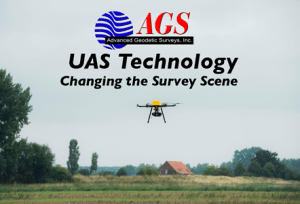 Unmanned Aircraft Systems (UAS), known more commonly as “drones,” are being put to use in ever more practical and ingenious ways across industries and applications. The surveying industry has rapidly adopted UAS as a new and powerful tool that not only allows for faster surveying in many instances but it also provides outstanding results for clients. At AGS we are pleased to carry an array of UAS for your land surveying needs.
Unmanned Aircraft Systems (UAS), known more commonly as “drones,” are being put to use in ever more practical and ingenious ways across industries and applications. The surveying industry has rapidly adopted UAS as a new and powerful tool that not only allows for faster surveying in many instances but it also provides outstanding results for clients. At AGS we are pleased to carry an array of UAS for your land surveying needs.
Applications For UAS Technology
UAS technology dramatically reduces the time and costs related to collecting aerial data for your land surveying missions. UASs provide unparalleled performance and reliability for an array of industries including:
- Agricultural & Forestry
- Civil & Heavy Earthworks Construction
- Engineering & Surveying
- Environmental & Landfill
- Mining
- Oil & Gas
- Petrol-Chemicals
- Public Agencies
What Can UAS Do For My Land Surveying Business?
Unmanned aircraft systems are packed with features to make your surveying more accurate, reliable and profitable. As with all technology, the longer it is available, the more affordable it becomes. Once only accessible to large organizations with strong cash flow or access to capital, UAS are now a cost-effective solution for nearly all professional surveyors.
So Why Invest In A UAS?:
- UAS allow land surveyors the ability to capture data from areas that were previously extremely challenging to reach or were highly hazardous in nature.
- Drones are very efficient. State-of-the-art data collection and cutting-edge software make spatial data collection via UAS easier and faster than traditional terrestrial surveying equipment.
- UAS can complete complex and challenging surveying projects faster and more accurately than terrestrial-based products or field personnel.
- UAS encompass advanced technologies that can serve numerous industries and can operate in nearly any topographical and aerial environment.
Types of UAS
There are two types of drones used in land surveying; the fixed-wing and the rotary-wing UAS.
Advantages of Fixed-Wing Drones
Fixed-wing drones have an appearance of a delta wing or traditional aircraft as opposed to rotary wing drones. Fixed-wing UAS advantages include; less maintenance and repairs compared to rotary wing drones due to less moving parts. Fixed-wing drones tend to be more stable and can glide over father distances thanks to their inherent aerodynamic design. Moreover, a fixed-wing drone, because of its wing design, can fly longer and carry heavier loads than a rotary wing drone. A considerable downside to a fixed-wing drone is that it need space to take – similar to an airplane needing a runway. Some fixed-wing drones come with launchers to help mitigate the need for a mini-runway so to speak.
Advantages of Rotary Wing Drones
Rotary UAS share a resemblance with helicopters because they use rotary blades like a helicopter to provide lift and not a wing as a fixed-wing drone does. The big advantages of rotary wing drones compared to fixed-wing ones is that they can take off and land vertically – they do not need any space to take off. Moreover, just like a helicopter, they can hover in position making them excellent for use in surveying inspections when your project requires more flexibility on where and how to place a drone to get the best images or scans.
Great Deliverables With Both Fixed-Wing & Rotary UAS
Both types of drone allow operators to produce the same robust range of deliverables for clients including:
- Topographic contours
- 3D surface models
- Orthophotographs
- Normalized Difference Vegetation Index (NDVI) maps
Contact Us
We are excited to offer these powerful surveying tools to you. Contact us today to learn more about what UAS best fits your needs and your client’s objective. As always, you can call or email us, or you can contribute to the conversation right here on our blog.

